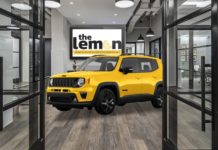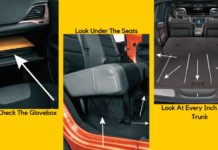Jeep owners have always been known to customize their vehicle. You’ve surely driven past a SUV that didn’t have a roof or door, or perhaps you’ve seen a more drastic modification. However, Jeep is now offering their customers a chance to enhance their vehicles unlike ever before.
Starting with the 2018 model year, the brand is planning on releasing a body-less version of each of their models. Now, Jeep owners will truly have an opportunity to enjoy the fresh air and all of the other natural advantages that accompany an off-roading excursion. The unprecedented SUVs will begin hitting dealers’ lots later this year.
“We pride ourselves on our products’ off-roading prowess,” Jeep said in a statement. “We’ve accompanied our most rugged vehicles with our “Trail Rated” badges throughout the years. However, even then, we felt like we could provide our customers with more. Now, thanks to the body-less variations of our various models, drivers can truly anticipate an unmatched off-roading experience.”
These specific versions of the model are a bit unorthodox, and the body structure is certainly unprecedented. Essentially, you should imagine a standard Jeep. Now take away all of the vehicle’s “walls.” That’s what you’ll be receiving when you opt for the “body-less” version of a Jeep. Specifically, Jeep cleverly removed the exterior of the vehicle and simply left the vehicle’s chassis, mechanical aspects, and interior amenities intact.
The brand had been quietly working on the design of their new Jeep variation for years, testing various test SUVs in their pursuit of the optimal ride. At first, the brand wasn’t so sure that the endeavor was even possible. However, before long, they realized that their dream could actually be a reality.
“It really wasn’t as hard to design as everyone thinks,” said chief engineer Miles B. Hind. “We were, like, all discussing how we could provide our customers with the best possible off-roading experience. I had been on a bit of a bender thenight before, so I just said “hey, what if we remove the vehicle’s walls?” After that, the magic happened.”
Once the brand had the idea, it didn’t take them very long to release their final product. Ultimately, engineers built the Jeep regularly, but they didn’t send their vehicles in for the final stage of the design phase: the exterior.
“At first I thought it was a joke,” said Titus Zell, who works in the brand’s production department. “Then I got the memo and I was like “oh, damn, this really isn’t a joke.””
Test drivers are already gushing about the new variation of the Jeep models, noting how it delivers a one-of-a-kind driving experience. Specifically, these drivers have noted that these revised Jeeps perform similarly to their former offerings, as the SUV is still capable of delivering all of the power and performance these customers have come to expect.
“I’m always seeking more fresh air,” said Jeep enthusiast Don Keigh. “Unfortunately, that wasn’t always possible when it came to my Jeep. Sure, I could remove the doors or the roof, but I still wanted to be fully immersed in the trail. Thanks to the body-less versions, that’s now a possibility! Plus, since I’m a giant tool, I want everyone on the road to know the music I’m listening to. Since there’s no body for my Jeep, all of my fellow drivers can listen in as I’m jamming to “Life is a Highway.””
Of course, some pundits have naturally pointed to the safety concerns as the major reason for why these vehicles should be avoided.
“There are a number of safety issues when it comes to the body-less Jeep,” said Debby Downer of the National Highway Traffic Safety Administration. “For starters, there’s no windshield, which means debris could easily fly up and injure the occupants. There’s no side-body protection, meaning the driver and passenger will be sitting ducks during a collision. This might honestly be the stupidest idea I’ve ever seen.”
In fact, one of the “test drivers” is suing the car brand due to injuries sustained during the testing period. The individual claims that Jeep didn’t make these individuals sign any waivers and the driver subsequently found themselves with several broken bones when a motorcycle accidentally went through the rear of the Jeep.
“There will be more of these lawsuits coming if Jeep doesn’t make these vehicles safer,” said attorney Hugh Janus. “This is a huge liability, and I guarantee that we’ll see more and more injuries as a result of this new offering.”
Of course, Jeep is still standing by the fact that their body-less Jeeps are safe. Despite the fact that there’s no exterior protection, the brand notes that the SUVs are equipped with all of the brand’s premier safety functions, which play a significant role in preventing accidents.
“Ultimately, if a driver of a body-less Jeep finds themselves in an accident, then it will be their own fault,” said Hind. “Our vehicles are plenty safe. If you take away the exterior, it really shouldn’t compromise the safety. In reality, the lack of walls should lead to a safer driving experience, as drivers will have a better vantage point of the road.”
Another major concern of a body-less Jeep is the SUV’s vulnerability when it comes to the elements. Naturally, consumers would assume that a rainstorm would completely soak the vehicle’s interior, which is certainly true. However, the brand certainly recognized this predicament, and that’s why they’ve included a standard tarp with each of their body-less vehicles. Owners simply have to throw the tarp on top of the vehicle, and they won’t have to have any concerns regarding an impending storm.
At the end of the day, this revolutionary design should change the entire automotive industry for the better. While it may take some time for consumers to get used to the body-less Jeep, you’ll be seeing these same individuals driving around town in the vehicles before long.












